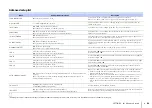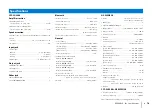
APPENDIX
➤
Glossary
En
77
Sampling Frequency and Bit Depth
These are values that represent the amount of information used to
convert analog signals to digital signals. They may be expressed as
48kHz/24bit, for example.
• Sampling Frequency
This defines the number of samples per second (sampling a finite
set of discrete values in an analog signal). The higher the
sampling rate, the broader the range of frequencies that can be
played back.
• Bit Depth
This defines the amplitude value of sounds when quantifying
analog signals as finite values. The higher the bit depth, the
deeper sounds are reproduced.
Deep Color
This is a video technology supported by the HDMI standard. It
processes RGB or YCbCr signals at bit depths of 10, 12, or 16 bits
per color, whereas conventional formats utilize only 8-bit processing,
enabling reproduction of more colors. Its gamut is comprised of a
billion or more colors, while the gamuts of conventional formats are
comprised of only millions of colors or less. This broader gamut
results in more precise reproduction of colors and greater detail in
darker portions.
Dolby Digital
This is a compressed audio format for 5.1 channels. It was
developed by Dolby Laboratories, and is widely used with DVD
discs.
Dolby Digital EX
This technology enables 6.1-channel playback for sources encoded
in the Dolby Digital EX format. It takes the Dolby Digital 5.1-channel
setup one step further with an additional back surround channel.
Dolby Digital Plus
This is a compressed audio format for 7.1 channels developed by
Dolby Laboratories. It is fully compatible with Dolby Digital and is
available for playback on Dolby Digital-enabled audio systems. It is
widely used with Blu-ray Discs.
Dolby Pro Logic II
This technology converts audio signal recorded in 2 channels to
5-channel signal. There are three modes available: “Music mode” for
stereo music sources, “Movie mode” for movie sources, and “Game
mode” for game sources.
Dolby Pro Logic IIx
This technology converts not only audio recorded in 2 channels, but
also audio signal recorded in multiple channels to discrete 7-channel
sound. There are three modes available: “Music mode” for music
sources, “Movie mode” for movie sources and “Game mode” for
game sources.
Dolby TrueHD
This advanced lossless audio technology was developed by Dolby
Laboratories for high-definition disc-based media to deliver sounds
that are identical, bit for bit, to studio masters for a great home
theater experience. It delivers up to 8 discrete channels of 24-bit/
96-kHz (up to 6 discrete channels of 24-bit/192 kHz) audio
simultaneously, and is widely used with Blu-ray Discs.
DTS Digital Surround
This is a compressed audio format for 5.1 channels developed by
DTS. It is widely used with DVD discs.
DTS Express
This is a compressed audio format for 5.1 channels. It provides a
higher compression ratio than the DTS Digital Surround audio format,
and was developed specifically for network streaming and Blu-ray
Disc secondary audio.
DTS-HD High Resolution Audio
This is a compressed audio format for 24-bit/96-kHz superior sound
quality with 7.1 channels developed by DTS. It is fully compatible
with DTS Digital Surround, and is widely used with Blu-ray Discs.
DTS-HD Master Audio
This advanced lossless audio technology was developed by DTS for
high-definition disc-based media to deliver sounds identical, bit for
bit, to studio masters for a great home theater experience. It delivers
up to 8 discrete channels at 24-bit/96 kHz (up to 6 discrete channels
at 24-bit/192 kHz) audio simultaneously, and is widely used with
Blu-ray Discs.
DTS Neo:6
This technology enables discrete 6-channel playback from 2-channel
sources. There are two modes available: “Music mode” for music
sources and “Cinema mode” for movie sources. It provides a channel
split effect similar to sources recorded as discrete surround sound.
HDMI
High-Definition Multimedia Interface (HDMI) is a digital audio/video
interface that has become an industry standard around the world. It
is capable of transmitting both digital video and audio signals intact
via a single cable. It is also compliant with the High-bandwidth Digital
Content Protection (HDCP) standard. See http://www.hdmi.org for
more information.
Pulse Code Modulation (PCM)
This technology records analog audio signals in digital form,
converts analog audio signals to digital audio signals, and transmits
analog audio signals in digital form. It is the underlying technology
for all digital audio signal systems, and is widely used with CDs,
Blu-ray Discs, and many other types of media as a uncompressed
audio format known as Linear PCM.
x.v.Color
This is a color space supported by HDMI. It has become an
international standard for video and offers a broader gamut than
does the sRGB standard for expression of colors never before
possible. It expands the color space while ensuring compatibility
with the sRGB standard for more natural and vivid images.
Glossary







































